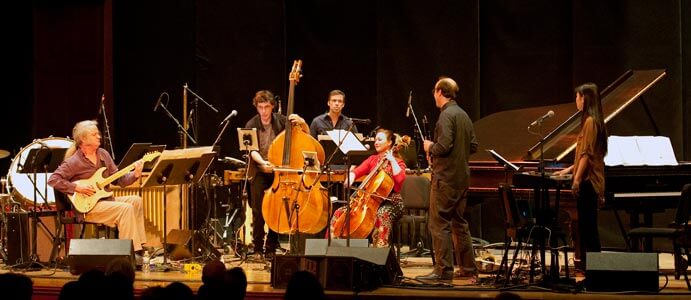Someone get pianist Vicky Chow some ice. If you counted her or percussionist David Cossin’s rapid, endless wrist bounces or the bow strokes of cellist Ashley Bathgate and bassist Robert Black during the Bang on a Can All-Stars’ performance on the Artist Recital Series at Finney Chapel, Oberlin College and Conservatory, on February 28, 2015, the number might well be in the millions.
For the All-Stars, who also include electric guitarist Mark Stewart and clarinetist/saxophonist Ken Thomson, performed mostly post-minimalist music consisting of quicksilver, incessantly looping rhythmic cells layered over each other in complex structures. After playing blistering repeated chords for over an hour, it’s a miracle Chow’s arms didn’t fall off.
Similarly miraculous is that the All-Stars never lost their place in the repetitious, byzantine repertoire, with its polyrhythms and erratic accents. The grooves that emerge from these uneven cycles were always impressive and, less often, irresistibly quirky.
But most of the pieces consisted almost solely of those unpredictable, fluctuating loops, which made for a homogenous evening. Though no composer was represented by more than one work, it sounded as if each had used the same compositional template and only colored it in differently.
Part of this may stem from the history of the All-Stars. The amplified group was formed in 1992 to tour and record with pieces commissioned and presented by Bang on a Can. That organization was founded by the post-minimalist composers David Lang, Julia Wolfe, and Michael Gordon, all of whom share a common aesthetic, and were featured on the program in Finney.

Bang on a Can All-Stars in Finney Chapel, Oberlin College and Conservatory (photo: Walter Novak)
The first piece, Lang’s Sunray, established the form. Multiple rhythmic strata shifted against each other in a molten mass, creating a drugged-out, claustrophobic mood that eventually grew into oppressive terror, with heavy metal fills from Cossin on a drum set.
Gordon’s For Madeline took that same format (minor-key, layered ostinatos) and added keening slides, sometimes mournful and sometimes alarming, like a siren. Again the piece built to a roaring conclusion.
Wolfe’s Believing, inspired by the psychedelic Beatles song “Tomorrow Never Knows,” was less successful, its hyperactive sections lacking the narrative cohesion of Lang’s and Gordon’s pieces.
Sectionalism was also a problem in Kate Moore’s Ridgeway. The rhythmic layering remained (as always), this time slightly obfuscated by dissonances and ripped tones. The portentous music could be likened to an ominous cloud of angry bees, swarming ever larger and ever closer.
The peak of the concert came with Steve Martland’s Horses of Instruction. With Black on electric bass, Cossin on drum set, Thomson on sax, and Stewart’s electric guitar, the piece could almost have been a progressive rock song by Yes or Rush. Eccentric riffs in uneven time signatures skipped along in rousing revelry, and the All-Stars were rewarded with hoots and stomps for their energetic efforts.
The electric excitement of the Martland dissipated in the last piece, Philip Glass’s cosmic Closing. Lacking the rhythmic insanity of the rest of the program, its meditative aura inspired one audience member to sprawl on her back in an empty pew, as though to find the sparkling stars suggested by the music amidst the shadowy eaves of Finney. Had she looked at the stage, she could have seen different kinds of stars, All-Stars, burning with rhythmic virtuosity despite the uniform sameness of their music.






















